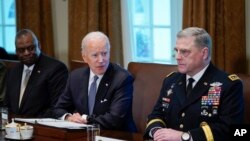U.S. President Joe Biden is due to speak Thursday about Russia’s invasion of Ukraine, including U.S. aid for Kyiv as his administration prepares another round of security assistance that is expected to total about $800 million.
The United States announced a similarly sized package last week, and the new aid is expected to include more artillery and tens of thousands more artillery rounds, which will likely be critical to the fighting in the eastern Donbas region.
Earlier in the week, Biden confirmed to reporters that he will send more artillery to Ukraine.
“Out of the $3.5 billion in drawdown authority Congress granted for this fiscal year, we have used over $2.4 billion to provide Ukraine the military equipment and capabilities they need to defend themselves,” a senior administration official told VOA. “We are continuing to look at additional security assistance we can provide to Ukraine, and there are additional authorities we can draw on if needed.”
The $3.5 billion is part of the $13.6 billion Ukraine Supplemental Appropriations Act Congress approved in March.
President confers with military leaders
As Russia launched new attacks Wednesday on the embattled Ukrainian port city of Mariupol, Biden convened his military leadership to get the latest assessment of the Russian invasion.
“I want to hear from all of you and your assessments on what you're seeing in the field and across our forces,” Biden said to top military brass at the White House before his meeting. “The strategic environment is evolving rapidly in the world, but that means our plans and force posture have to be equally dynamic.”
Biden met with combatant commanders, including Secretary of Defense Lloyd Austin, Chairman of the Joint Chiefs of Staff General Mark Milley, and approximately two dozen other military leaders and national security advisers.
Earlier Wednesday, the U.S. slapped new sanctions on dozens more individuals and entities accused of evading ongoing financial penalties imposed on Moscow for its invasion of Ukraine.
“The Department of Treasury sanctions Transkapitalbank — a key Russian commercial bank that has offered services to banks globally to evade international sanctions, and more than 40 individuals and entities that are part of a Russian sanctions-evasion network led by Russian oligarch Konstantin Malofeyev,” White House press secretary Jen Psaki told reporters.
Psaki said Washington also has imposed sanctions on companies in Russia's virtual currency mining industry and applied visa restrictions on more than 600 individuals in response to human rights abuses by Russia and Belarus.
Michael O’Hanlon, senior fellow and director of research in foreign policy at the Brookings Institution, told VOA that in addition to military assistance and economic sanctions, Washington must start thinking about plausible end states of the conflict.
“And then, think of what we can do to encourage the parties, working with other outside actors, even the Chinese perhaps, to try to get to some kind of a place we can all live with, compared to the alternative of this turning into a multi-month or even multi-year conflict,” O’Hanlon said. “But for the short term, we're just trying to help the Ukrainians not lose.”
Battle for Mariupol
More than 100,000 Ukrainians are believed to be trapped in Mariupol, where 400,000 people lived before Russia invaded the country on February 24.
"The conditions there are truly horrific," U.S. Secretary of State Antony Blinken said Wednesday at a diplomatic conference in Panama. He underscored that attempted humanitarian corridors to allow Mariupol residents to escape "have fallen apart very quickly."
The fight over Mariupol is part of a broader Russian offensive in the strategically important Donbas region, where Moscow has been boosting its military presence.
“Moscow’s current objective is to broaden its control in the East and South. Ideally, they would like to grab Kharkiv and Odesa,” John E. Herbst, senior director of the Atlantic Council’s Eurasia Center and former U.S. ambassador to Ukraine, told VOA. “But those are tall orders. They may have to settle for Mariupol.”
On March 25, following losses in northern Ukraine, Moscow announced a major shift in strategy and removed forces from the north, including the suburbs of the capital, Kyiv, to consolidate military gains in the Donbas and establish a land bridge to Crimea.
Analysts say if Russian forces gain complete control of the Donbas, their diplomats will hold a stronger hand in peace negotiations and be in a better position to demand autonomy for the region.
“But even if he [Russian President Vladimir Putin] makes large gains in the East and South and accepts a settlement that gives him control of his new conquests, that does not mean that he will be satisfied,” Herbst said.
U.S. Defense Department analysts say the battle for the Donbas region, where fighting has been ongoing since Moscow’s annexation of Crimea in 2014, could last for months more.
VOA’s Anita Powell and Steve Redisch contributed to this report. Some information for this report came from The Associated Press and Reuters.









